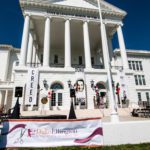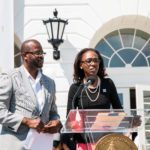On Aug. 19, in front of its white-columned portico, Mayor Muriel Bowser, District of Columbia Public Schools Chancellor Antwan Wilson and others welcomed students, faculty, administrators and friends of the Duke Ellington School of the Arts “back home.” Concluding almost three years’ worth of restoration, reconstruction and expansion at the Classical Revival landmark on 35th Street, the ceremony was marked by expressions of gratitude, pride and optimism.
To begin, recent Ellington grad Tony Donaldson, referencing the recent events in Charlottesville, Virginia, called the school “the artistic antidote to hate.” School cofounder Peggy Cooper Cafritz proclaimed, “Artists, yes, but citizens first. We are a beacon of leadership, and, as citizens, we are obligated to share our success.”
Another Ellington alum, opera star Denyce Graves, sang “The Impossible Dream” from “Man of La Mancha,” summing up the morning’s symbolism just prior to the ribbon-cutting.
“This is now the premier high school for the arts in the United States,” declared Bowser, who said the extra money spent [$100 million over budget] was worth it. She was joined by Wilson, Cafritz, Council members Jack Evans, David Grosso and Brandon Todd, Deputy Mayor for Education Jennifer Niles, D.C. Department of General Services Director Greer Johnson Gillis, Interim Head of School Sandi Logan and Ellington board members. The crowd of more than 300 included Burleith and Georgetown neighbors along with Ellington students.
After the speeches, fleeing a blazing summer sun, the attendees poured into the stunning — and air-conditioned — interior of glass, wood and metal. Many stopped and gasped. “Oh, my God,” was frequently exclaimed.
A School Reborn
Nothing of the old entrance with its narrow hall, corridors and multi-doored access to the auditorium remained. Instead, the entrance hall widened into a sweeping balcony with a spacious student union below and three floors of classrooms facing balconies above. Arched bridges on either side of the entrance floor led to a giant sphere occupying the four floors at the building’s center. The globe contains a state-of-the-art, 300-seat auditorium.
Large signage on each level indicates the locations of the school’s specialized arts and academic departments. Visitors peeked into multiple dance studios with polished wooden floors, barres attached to the walls and floor-to-ceiling windows. At the front of the building, the “Media Center” led to a central balcony overlooking the school’s front lawn. Sleek lounge chairs, tables and chairs were ready to welcome students to relax and enjoy the view.
Students and Curricula
Clowning around joyfully in the cafeteria downstairs in front of the fitness center and steam room were Adobe Amanche, Mina Swaminathan, Kai Isaac, Ceci Smith and Austin Burkett, sophomore- and junior-year students radiantly happy to see their new school building for the first time. Two are focusing their studies on vocal performing arts, two on creative writing and one on museum studies.
“Before the school was spread out between two buildings for academic and arts studies,” Burkett said. “Now, we’ll be together in one and the programs can coordinate each other.”
The new multiple dance studios thrilled them particularly. “Before, we only had one for the dance program that various classes had to share,” Burkett said. “But the vocal department has show classes and the theater department has movement classes that all require dance floors. Before, we were practicing on carpet.” Those departments traditionally put on two big shows a year and tour small shows around the city. Now, it is expected they will do more, Burkett’s mother added.
The student body at the renovated facility, a magnet school for the performing arts, is projected to grow by 10 percent. “We need more students,” some of those interviewed said. (There are currently about 530.) While academic classes can be around 20 in enrollment, some of the performing arts classes are as small as five. Admission is by audition. The school is open to students from outside the District of Columbia, although they are charged a substantial tuition; D.C. students pay only a small arts fee.
The School’s Past and Future
The dual-curriculum arts focus at the school was established in 1974 and the Duke Ellington School of the Arts took over the longtime Western High School four years later. “By naming one of his jazz bands the Washingtonians, Duke Ellington made his home [Washington, D.C.] part of his persona,” according to the school website. “D.C. philanthropist and avid art collector Peggy Cooper Cafritz and the late dancer and choreographer Mike Malone returned the favor over the years, building the school to house the creative soul of the District, and to reflect the rich cultural diversity of the United States. From the beginning, public and private partnerships have supported the school.” The school partners with the John F. Kennedy Center for the Performing Arts and George Washington University.
The mission of the school is to nurture and inspire passion for arts and learning in students who might not otherwise have an opportunity to develop their artistic skills. “We ensure that our students are prepared for post-secondary education and/or careers in the arts by offering an intensive arts-based program,” the mission statement declares. “We prepare our students to become productive citizens in our global society through our strong focus on community service.”
In 2010, there was talk of moving the school to the center of the city and making the building, completed in 1898, a regular public high school again for Ward 2, which has none. The notion was quickly shot down.
The renovation and expansion project ran far over budget. Initially estimated at $71 million, over a period of three years the costs grew to more than $178 million. In addition, the renovations experienced substantial delays. While the project was scheduled to start June 15, 2013, actual construction did not begin until April 2015. The groundbreaking was in December 2014 under Mayor Vincent Gray and Chancellor Kaya Henderson.
The project was overseen by the Department of General Services. Architectural design was by a joint venture of Georgetown-based Cox Graae + Spack and Lance Bailey & Associates in D.C. and Silver Spring.
Duke Ellington School of the Arts
3500 R St. NW, Washington, DC
The renovated 279,524-square-foot building includes:
800-seat, state-of-the-art main theater
300-seat recital hall
150-seat black box theater
Rooftop educational terrace
Six dance studios
Four art studios
Printmaking studio
Two digital art studios
Three theater studios
Two technical design and production studios
Paint/scene shop
Costume shop
Four makeup rooms
Multiple vocal labs
Multiple instrumental music labs
22 Practice rooms
Seven lesson studios
Six graphics/sound/film/video labs
Two writing and journalism labs
Two museum studies labs
Two biology labs
Two chemistry labs
Physics lab
Underground parking garage with approximately 50 spaces
- The front facade of the renovated Duke Ellington School of the Arts on 35th Street. Photo by Ari Golub.
- The school is full of light and walkways. Photo by Ari Golub.
- Mayor Muriel Bowser with school co-founder Peggy Cooper Cafritz at the grand opening. Photo by Bill Starrels.
- D.C. Public Schools Chancellor Antwan Wilson and Department of General Services Director Greer Johnson Gillis at the grand opening. Photo by Ari Golub.
- Ellington students at the school’s open house Aug. 19: Adobe Amanche, Mina Swaminathan Kai Isaac, Ceci Smith and Austin Burkett. Photo by Ari Golub.
- The school is full of light and walkways. Photo by Ari Golub.
- At the lineup for the Aug. 19 ribbon cutting: Department of General Services head Greer Johnson Gillis, D.C. Public Schools Chancellor Antwan Wilson, Council member Jack Evans, Mayor Muriel Bowser, school co-founder Peggy Cooper Cafritz and others. Photo by Robert Devaney.









